A friend gave me a Threshold 4000 that was in need of help. Both channels seem to be shorted. Here is the worst one.

Jon at vintageamprepair.net help me with the output sub. Here it is back together. There is still something not right. See the voltages in the picture at 120volts input. The 1k resistors number 3 & 4 get hot pretty quick.
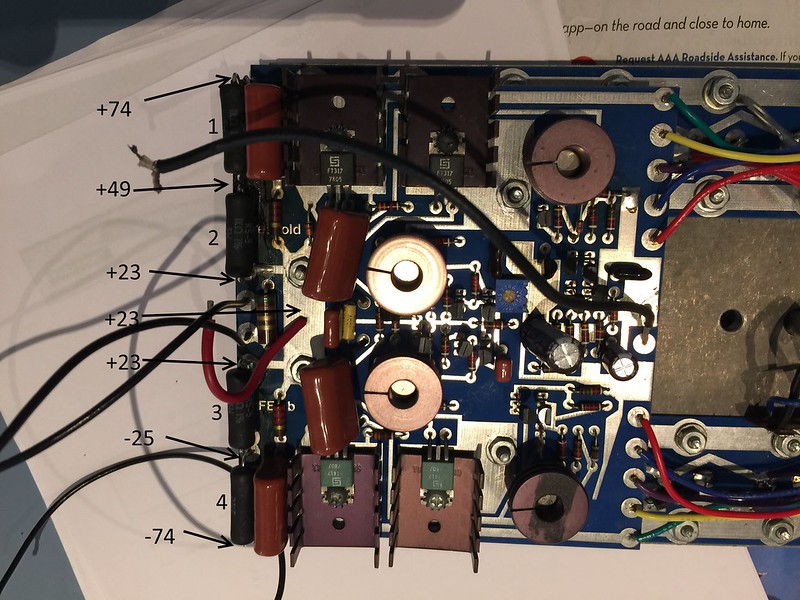
What should I check next?
This schematic shows the differences I have seen on my board so far. I moved it here from post 17 so I can update it.

400
 Volts30 with working no outputs
Volts30 with working no outputs
 diode fixed
diode fixed
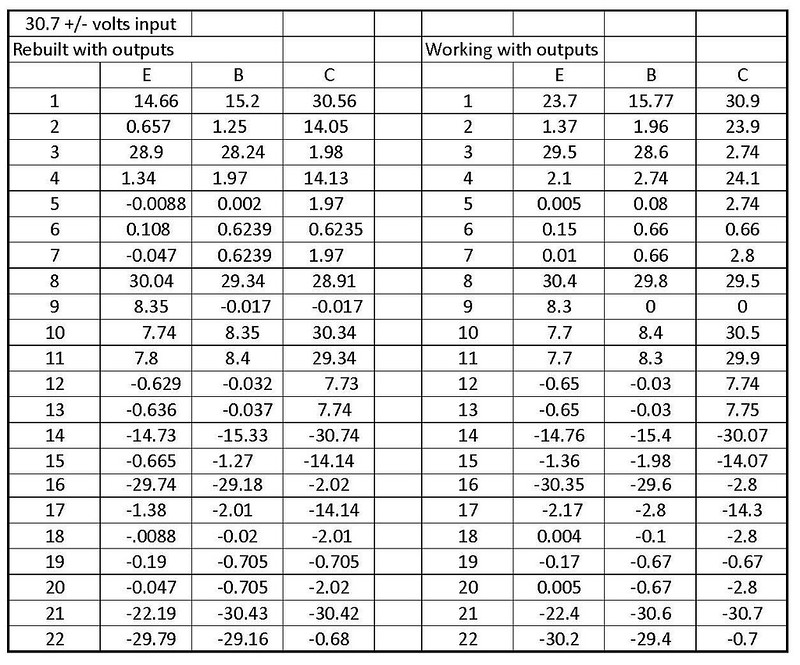 Volts30 with rebuilt
Volts30 with rebuilt

Jon at vintageamprepair.net help me with the output sub. Here it is back together. There is still something not right. See the voltages in the picture at 120volts input. The 1k resistors number 3 & 4 get hot pretty quick.

What should I check next?
This schematic shows the differences I have seen on my board so far. I moved it here from post 17 so I can update it.

400



Last edited:
I see you already replaced all tantalums
whatever , my usual procedure with amps that burned , is to check every resistor in situ; if I have some doubts in measurement , desoldering and lifting one end of resistor is enough to clear doubt .
same applies for diodes
also - fastest way is to , one by one, desolder each semiconductor , test it and put it back or replace , if bad .
whatever , my usual procedure with amps that burned , is to check every resistor in situ; if I have some doubts in measurement , desoldering and lifting one end of resistor is enough to clear doubt .
same applies for diodes
also - fastest way is to , one by one, desolder each semiconductor , test it and put it back or replace , if bad .
I was hoping to find a shortcut as there are a lot of transistors on there. I guess I will get to work.
Tony
Tony
shortcuts through mileage ; no other way
though , in case of that ,you wouldn't ask for advices , maybe just for schematic
though , in case of that ,you wouldn't ask for advices , maybe just for schematic
I have this schematic.
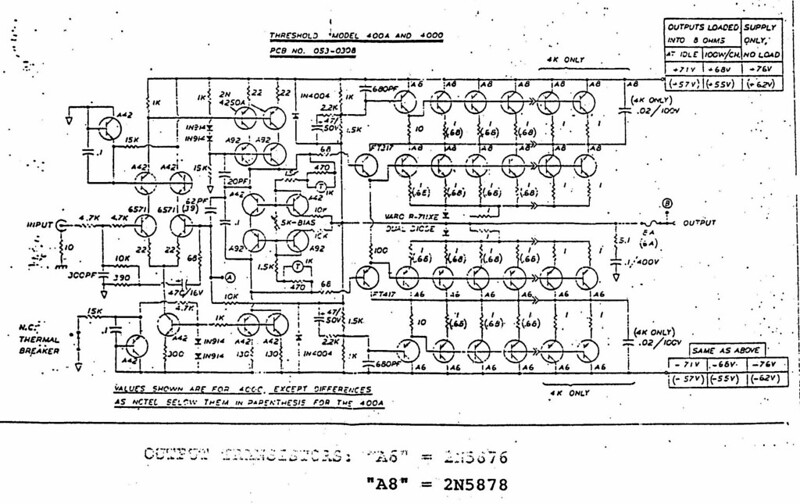
I checked everything on the board and all test OK. The bias trimmer is set to 1.5K ohm is that a good starting point.

I checked everything on the board and all test OK. The bias trimmer is set to 1.5K ohm is that a good starting point.
recheck everything
bias value isn't critical to offset , which is too high
if you have same offset on both channels , you have same mistake/culprit on both
bias value isn't critical to offset , which is too high
if you have same offset on both channels , you have same mistake/culprit on both
it really depends how much is biased
I believe it can be anything between 20 to 80W/channel , plus general losses ..........
I believe it can be anything between 20 to 80W/channel , plus general losses ..........
A friend gave me a Threshold 4000 that was in need of help. Both channels seem to be shorted. Here is the worst one.
Jon at vintageamprepair.net help me with the output sub. Here it is back together. There is still something not right. See the voltages in the picture at 120volts input. The 1k resistors number 3 & 4 get hot pretty quick.

What should I check next?
The voltage at the joint of resistors No:3 and 4 must be same as above (49V) at the positive side.
No power supply schematics ?
Where is that joint connected to ?
+23V must be 0 Volts (assuming it is connected tothe output through fuse).
Last edited:
yeah , it must be the same - that's voltage reference for upper and lower cascodes
see at sch 1K and 1K5 (though - it would be good to recheck their position , it looks suspicious on pic ...... 1K5 inside , 1K outer - to rails)
see at sch 1K and 1K5 (though - it would be good to recheck their position , it looks suspicious on pic ...... 1K5 inside , 1K outer - to rails)
Yes. And resistors 1 and 4 must be 1.5K according to schematics. He says 1K. Neverthe less this may not be cause of problem.
same problem on both channels + 23Vdc offset , that means systematic mistake or same blown parts
no shortcut , thorough checking of all active an passive parts .......
no shortcut , thorough checking of all active an passive parts .......
It may not be systematic.
The positive and negative sides should have same resistance at quiescence in order to get a zero voltage at common line which is also output. But in his case, resistance of positive side is higher than negative. This may happen because of any part at upper or lower.
Anyway, in my opinion it is likely a bad one at upper side.
To localise it,
i would first disconnect the upper and lower power transistor blocks (A6-A8) from the rail voltages (+-74V) and re-check voltages. This will save him time.
The positive and negative sides should have same resistance at quiescence in order to get a zero voltage at common line which is also output. But in his case, resistance of positive side is higher than negative. This may happen because of any part at upper or lower.
Anyway, in my opinion it is likely a bad one at upper side.
To localise it,
i would first disconnect the upper and lower power transistor blocks (A6-A8) from the rail voltages (+-74V) and re-check voltages. This will save him time.
Here is the back side of the board.
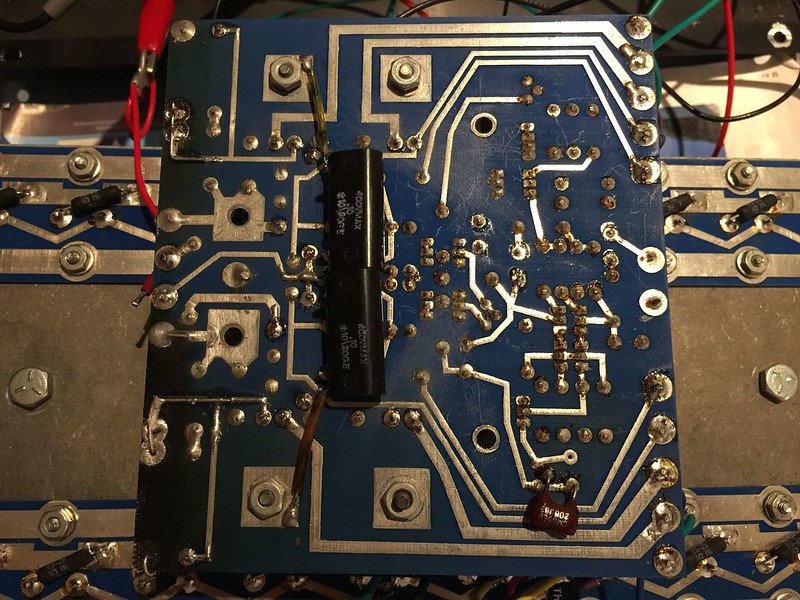
And the power supply.
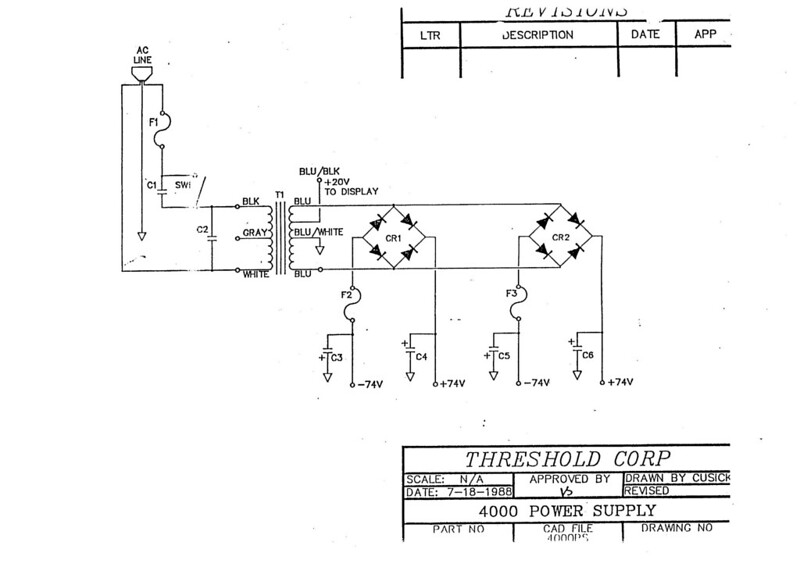
One goes to the collector of a FT317 and a 10uf cap to a 2.2k resistor to the output. The other to a FT417 and a 10uf cap to a 2.2k resistor to the output.
It is connected to the output.
I think I see this on the schematic but not on the board. This is a pc FE1b board.

And the power supply.

Where is that joint connected to ?
One goes to the collector of a FT317 and a 10uf cap to a 2.2k resistor to the output. The other to a FT417 and a 10uf cap to a 2.2k resistor to the output.
+23V must be 0 Volts (assuming it is connected tothe output through fuse).
It is connected to the output.
see at sch 1K and 1K5 (though - it would be good to recheck their position , it looks suspicious on pic ...... 1K5 inside , 1K outer - to rails)
I think I see this on the schematic but not on the board. This is a pc FE1b board.
not enough info to help or , more precise , my hands are too short for that
as I said , you need someone with greater mileage to lay hands on it
as I said , you need someone with greater mileage to lay hands on it
I think I see this on the schematic but not on the board. This is a pc FE1b board.
I was a few post behind. I get it now. I went with what was in there before. This channel looks original. There are a number of changes on this one.
i would first disconnect the upper and lower power transistor blocks (A6-A8) from the rail voltages (+-74V) and re-check voltages. This will save him time.
This will be the next step. I need to put everything back on the board first. It may be the weekend before I get to it.
Thanks for the help.
Tony
This schematic shows the differences I have seen so far.
schematic
An externally hosted image should be here but it was not working when we last tested it.
schematic
to check pcb part only :
disconnect power rails to output bank
disconnect base wires to output bank
what's offset then on output?
disconnect power rails to output bank
disconnect base wires to output bank
what's offset then on output?
With power just going to the board and no outputs hookup I get this. Transistor B is -23volts. I have not had time to think about it yet.
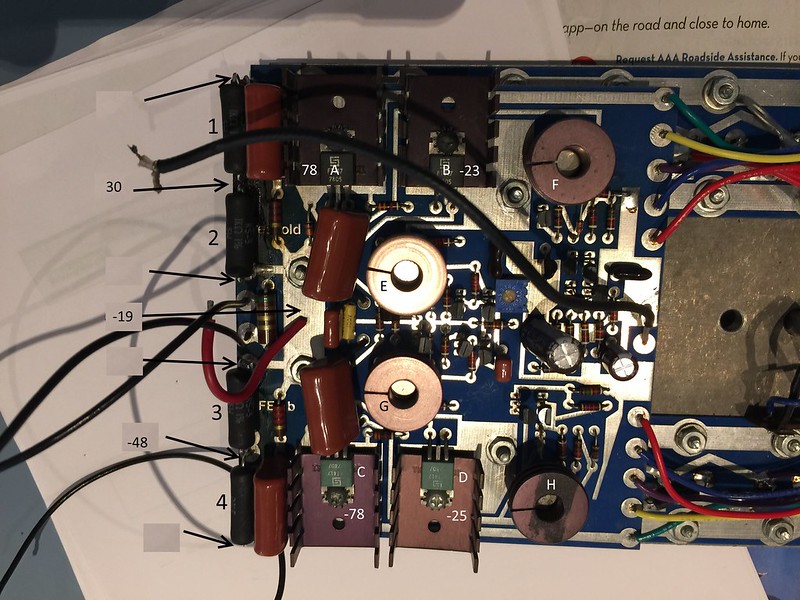 IMG_1949 volts no outputs
IMG_1949 volts no outputs

Last edited:
take sch and write voltages on proper nodes
as many you can .......
if edited is too big for posting here and you're having trouble to shrink it properly , send it to me and I'll post it here (that , seeing that flickr linked one is Dodo)
>sasica5@gmail.com<
as many you can .......
if edited is too big for posting here and you're having trouble to shrink it properly , send it to me and I'll post it here (that , seeing that flickr linked one is Dodo)
>sasica5@gmail.com<
- Home
- Amplifiers
- Pass Labs
- Threshold 4000 repair. Need some help.